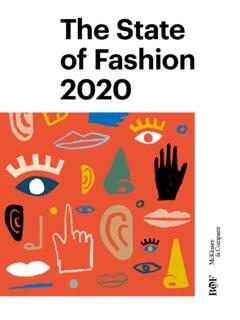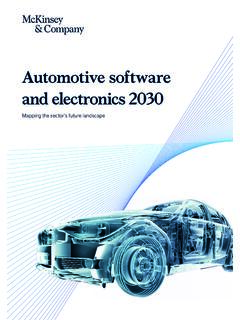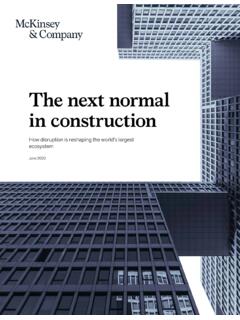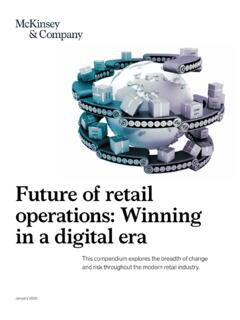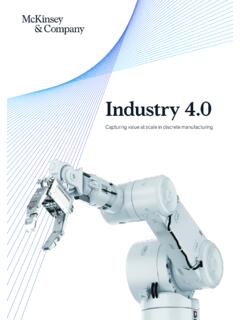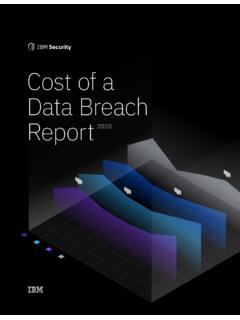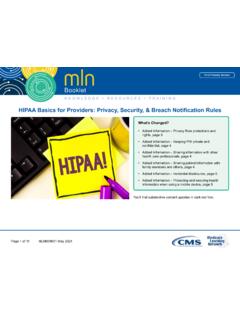Transcription of Cybersecurity in automotive - McKinsey & Company
1 Cybersecurity in automotiveMastering the challenge March 2020 Cybersecurity in automotiveMastering the challenge AcknowledgementsThis study was conducted by McKinsey & Company , Inc. We wish to express our appreciation and gratitude to GSA and its members for their continued support and valuable contributions. AuthorsOndrej BurkackyJohannes DeichmannBenjamin Klein Klaus PototzkyGundbert Scherf 2 Cybersecurity in automotiveIntroduction and key insights ..41. Cybersecurity is becoming a new dimension of quality for automobiles ..52. automotive industry is rethinking Cybersecurity along the entire value chain ..93. Managing cyber risk throughout the vehicle lifecycle will require new working practices ..174. automotive executives should prepare their Cybersecurity strategy ..21 Outlook ..28 Appendix ..29 Key aspects of the market model ..30 List of and authors ..32 Important notice.
2 33 Contents3 Cybersecurity in automotiveIntroduction and key insightsThe four ACES disruptions autonomous driving, connected cars, electric vehicles, and shared mobil- ity have dominated the agenda of automotive indus-try leaders in recent years. These innovations, built on the digitization of in-car systems, the extension of car IT systems into the back end, and the propagation of software, turn modern cars into information clear-inghouses. Hacking of connected cars by security researchers has made headlines over the past few years, and concerns about the Cybersecurity of modern vehicles have become real. Lately, regu- lators have also started working on defining the minimum Cybersecurity requirements for new cars. The UNECE regulation on Cybersecurity and software updates is on the horizon and will trigger a paradigm shift in the automotive industry in the UNECE member countries.
3 Other countries like the US and China have issued best practices and frameworks but no regulations yet. Given the influence of UNECE, however, a broad adoption of its regulation across the world is these first regulatory programs for cyber-security and software updates in the automotive sector, the regulator will require automotive OEMs the responsible parties for vehicle homo- logation to demonstrate adequate cyber-risk management practices throughout development, production, and postproduction of their vehicles, including the ability to fix software security issues after the sale of vehicles and over the air. In this context and based on our extensive research and analyses, we offer a perspective on three key questions for the automotive industry: What are the specific trends and drivers of cyber-security in the automotive industry and why is this a paradigm shift for the industry?
4 How are these drivers going to affect the auto-motive industry s long-established value chains? How can players inside and outside the industry 1 UNECE, Proposal for a new UN Regulation on uniform provisions concerning the approval of vehicles with regard to cyber security and of their Cybersecurity management systems; UNECE, Proposal for a new UN Regulation on uniform provisions concerning the approval of vehicles with regard to software update processes and of software update management systems. prepare and position themselves for the upcom-ing market developments and anticipated seg-ment growth?While the following paragraphs provide a summary of our research, the remainder of the report will address these questions in power, fuel consumption, driving comfort, and the precision of a car s chassis and body are just a few dimensions that define the quality of a car. With more and more core vehicle functions enabled by software running on specialized hardware chips, the security of those components Cybersecurity will become yet another dimension of quality in the automotive industry, in much the same way that physical safety is a major concern and quality parameter measure of quality is underpinned by regulatory activities that impose minimum standards for man-aging Cybersecurity risks and require OEMs to have the ability to fix security issues via software updates.
5 Cybersecurity will become nonnegotiable for the order to excel at Cybersecurity , new processes, skills, and working practices along the automotive value chain will be required. This includes identifying cyber risks, designing secure software and hardware architectures, and developing and testing secure code and chips, ensuring that issues can be fixed even years later via software updates. The rising need for Cybersecurity will trigger invest-ments over the next few years. We expect to see the market grow from USD billion in 2020 to USD billion in 2030, with software business representing half of the market by 2030. The strong growth of the market will create many new business opportunities for suppliers, established IT firms, specialist niche firms, start-ups, and many others, especially in the software development and services market. At the same time, the dynamics of the growing market will also challenge today s leaders in the in automotive1.
6 Cybersecurity is becoming a new dimension of quality for automobiles5 Cybersecurity in automotiveSoftware is one of the key innovations in modern vehiclesSoftware and electrical/electronic (E/E) compo-nents are and will continue to be among the key innovations in modern vehicles. The market is expected to grow from USD 238 billion in 2020 to USD 469 billion in 2030, corresponding to an annual growth of over 7 percent per growth is driven to a large extent by software, which is becoming a key differentiator. Software is driving innovation in the four ACES categories: Autonomous. Autonomous cars, which have been the subject of fantasy for a long time, are becoming reality. Leading companies have already driven millions of miles on public roads with them, but so far always under the watchful eye of a human behind the steering wheel. The disengagement rate in field tests, , how often the human driver needs to take over control, is rapidly declining, putting fully autonomous cars in reach within mere years.
7 While the autonomous car offers great advantages, it comes with the risk of hackers interfering with steering or breaking. Such incidents would foster fear of autonomous cars and put the whole technology at risk. Connected. Cars are becoming more and more connected. The services enabled by connectivity today range from sending destination address-es to the vehicle, to receiving real-time traffic information, to parking the vehicle remotely via a smartphone app. However, the connectivity of cars is a potential attack vector for hackers to compromise a full fleet of cars, which is the worst nightmare of every OEM. Electric. The rise of electric cars started several years ago and they are gaining more and more traction as their range increases and their price decreases. Challenged by many start-ups, almost all incumbent OEMs have embarked on the journey to including electric cars in their product portfolios.
8 The electric car per se is not more susceptible to sabotage than a con-ventional car, but attacks on charging infra-structure can have severe effects, from power outages to fires. Shared. Enabled by connectivity, new busi-ness models for transportation have become viable, such as car sharing and ride hailing. The trend in mobility is moving away from car ownership and towards shared-car solutions, 2 Source: McKinsey , Mapping the automotive software-and-electronics landscape through 2030, July Source: McKinsey , The race for Cybersecurity : Protecting the connected car in the era of new regulation, October is significantly increasing vehicle utilization. This trend requires full protection of user data a breach of sensitive data could foster massive distrust of the business deeper look into the connected car shows three types of software that will drive innovation in this area: In-vehicle services: All software within the vehicle that runs on electronic control units (ECUs) or domain control units (DCUs) within the car OEM back-end services: Cloud services for both the vehicle and user Infrastructure and third-party services.
9 Software links between the vehicle and infra-structure, , gas/charging, parking, the industry is investing in innovations across these types of software to enhance the customer experience and increase the value of modern cars, manufacturers must also build in Cybersecurity from the beginning to avoid creating cyberattack-prone digital platforms and every line of code, the cyber risk to modern vehicles increases, and security researchers have demonstrated its impact and costOver the last several years, modern cars have become data centers on wheels. Comparing the lines of code in modern connected cars with aircrafts and PCs provides a glimpse into the challenges of securing these vehicles. Today s cars have up to 150 ECUs and about 100 million lines of code; by 2030, many observers expect them to have roughly 300 million lines of software code. To put this into perspective, a passenger aircraft has an estimated 15 million lines of code, a modern fighter jet about 25 million, and a mass-market PC operating system close to 40 This abundance of complex software code is a result of both the legacy of designing electronic systems in specific ways for the past 35 years and the growing requirements and increasing complexity of systems in connected and autonomous cars.
10 This amount of code creates ample opportunity for cyberattacks not only on the car itself but also on all components of its eco-system ( , back end, infrastructure).The cyber risk of connected cars has become clear over the past few years, as security researchers have revealed various technical vulnerabilities. In these scenarios, the attackers were not exploiting the vulnerabilities with bad intentions but rather 6 Cybersecurity in automotivedisclosing information to OEMs to help them fix those issues before malicious attackers caused actual harm. Some of the recently reported vulnera-bilities are listed in Exhibit becoming aware of the vulnerabilities, OEMs fixed the issues and provided software updates. But, depending on the affected car model, its E/E architecture, and the OEM s ability to provide soft-ware updates over the air, some software updates required visits to dealerships, resulting in much higher costs for will be nonnegotiable for securing market access and type approval in the futureUnlike in other industries, such as financial ser-vices, energy, and telecommunications, cyber-security has so far remained unregulated in the automotive sector but this is changing now with the upcoming UNECE regulations on 4 UNECE, Proposal for a new UN Regulation on uniform provisions concerning the approval of vehicles with regard to cyber security and of their Cybersecurity management systems.


